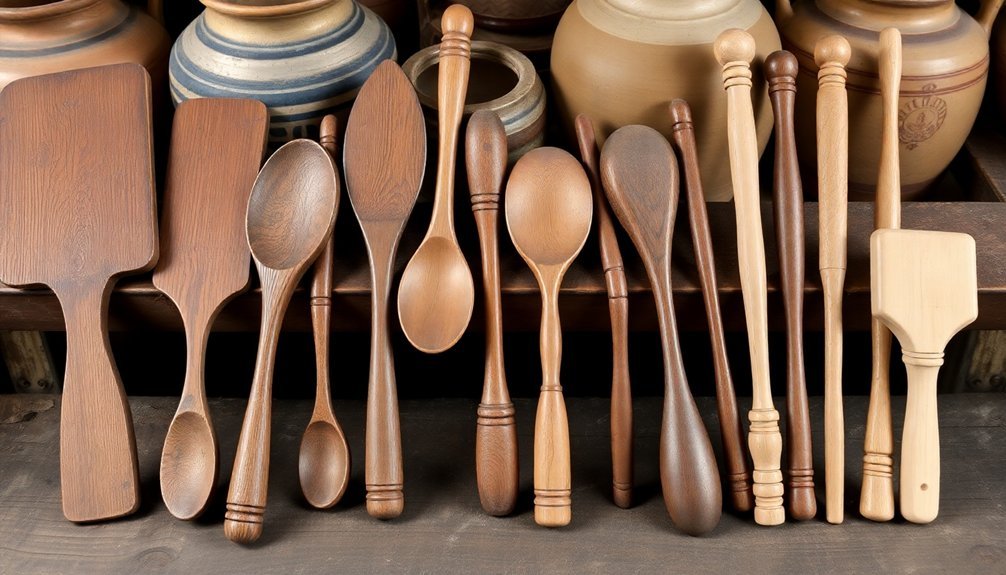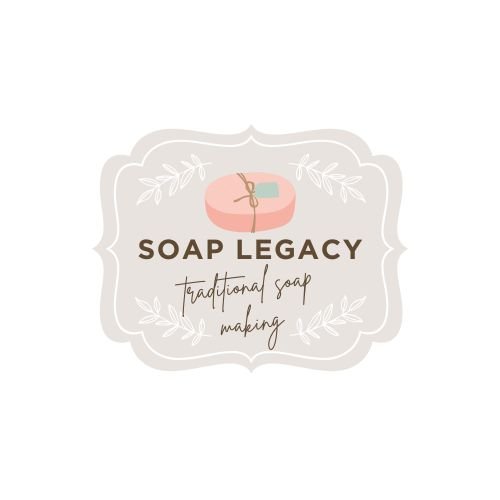Traditional lye crafting relied on sturdy wooden paddles and long-handled spoons made from hardwoods like maple, oak, and hickory. You'll find these tools featured lengths of 24-36 inches to prevent burns during stirring. Notched sticks served as primitive but effective measurement tools for testing lye concentration. Regional variations emerged based on local needs – from narrow Appalachian paddles to wider Great Plains versions. These implements weren't just practical tools, but cultural artifacts that tell a deeper story of community craftsmanship.
Historic Stirring Tools for Traditional Lye Crafting

While modern soap makers often use specialized equipment, traditional lye crafting relied on simple yet effective stirring tools designed to withstand harsh chemical reactions.
You'd typically find wooden paddles or long-handled spoons in a soap maker's arsenal, allowing safe stirring from a distance to avoid caustic splashes during the saponification process.
Some crafters preferred natural materials like reeds or bamboo, which offered flexibility while maintaining durability against lye's corrosive properties.
When metal tools were necessary, careful selection of wrought iron or tin prevented unwanted chemical reactions with the lye solution.
Regardless of material, these tools served one essential purpose: maintaining consistent agitation until reaching "trace" – that critical moment when the mixture thickened enough for pouring into molds.
Wooden Paddles and Spoons: Materials and Evolution

Because success in traditional lye crafting depended heavily on proper tools, wooden paddles and spoons became the cornerstone implements for generations of soap makers.
You'd find these essential stirring tools crafted from hardwoods like maple, oak, and hickory—chosen specifically for their durability and resistance to splintering when exposed to caustic lye mixtures.
These paddles, typically measuring 24-36 inches long, allowed you to safely stir hot mixtures without risking burns. Their thoughtful design featured rounded edges and wide surfaces that efficiently mixed thick soap without damaging your containers.
Over time, the evolution of wooden paddles reflected broader manufacturing changes, shifting from individually hand-carved pieces to commercially produced options.
Craftspeople maintained these valuable tools by treating them with food-safe oils, extending their lifespan through generations of soap making.
The Significance of Hardwood Stirrers in Colonial Soap Making

Colonial America's soap makers elevated hardwood stirrers from simple utensils to vital instruments of their craft. You'll find these tools were meticulously selected from local oak or maple trees, offering significant resistance to the caustic lye solutions that would quickly destroy lesser implements.
| Stirrer Feature | Benefit | Soap Making Application |
|---|---|---|
| Length (2-4 ft) | Safety distance | Protected hands from lye splashes |
| Smooth surface | Prevented clumping | Enhanced saponification process |
| Flat carved end | Better mixing | Incorporated air for proper trace |
| Hardwood material | Durability | Withstood repeated use with fats |
| Local sourcing | Self-sufficiency | Aligned with colonial values |
These hardwood stirrers weren't merely functional—they represented the practical ingenuity of colonial craftspeople who transformed raw materials into tools that perfectly suited their soap making needs.
Notched Sticks and Their Purpose in Lye Testing

You'll find that notched sticks served as essential testing tools for pioneer soap makers who needed to gauge lye concentration without modern equipment.
These simple wooden implements allowed craftspeople to "read" the strength of their lye solution by observing how the liquid clung to the notches and whether bubbles formed around them.
Pioneer Testing Tools
Ingenuity defined the pioneer approach to soap making, particularly in their methods for testing lye.
Among their most practical innovations was the notched stick—a simple yet effective tool for determining lye solution strength.
You'd dip your notched stick into the freshly prepared lye, then observe how deeply the solution filled the notch. A deeper fill indicated a stronger concentration, confirming your solution was ready for saponification with animal fats or vegetable oils.
Without modern pH meters, this visual assessment provided reliable feedback about when your lye had reached ideal strength.
The notched stick method exemplifies the resourcefulness of early soap makers, who transformed ordinary wood into precision testing instruments.
It's a proof of how pioneers crafted quality soap using only what nature provided and their own observational skills.
Reading Lye Strength
Several key methods helped our ancestors accurately gauge lye potency, with notched sticks standing as perhaps the most ingenious solution.
You'd create these simple tools by carving measured notches into wooden sticks, then immerse them into your lye solution to observe the results. The higher the lye climbed up the notched stick, the stronger the concentration.
You could quickly determine if your lye was suitable for soap-making by checking which notch the solution reached. Many crafters marked their sticks with specific measurements, creating a reliable reference system.
When precise instruments weren't available, these notched sticks provided the accuracy needed to guarantee proper chemical reactions in your soap-making process.
This straightforward method allowed you to confidently produce quality soap despite limited technology.
Hand-Carved Soap Dashers: Form Follows Function

While modern soap making often relies on electric mixers, traditional hand-carved soap dashers represent a perfect marriage of artistry and utility in the craft of lye soap production.
You'll notice these tools feature long handles and wide, flat paddles specifically designed to efficiently blend lye and fats during the soap-making process.
Craftsmen select hardwoods like maple or oak that resist warping when exposed to hot soap mixtures. The form follows function principle is evident in every aspect—from the comfortable grip to the maximized stirring surface.
Many dashers display decorative carvings that celebrate soap-making heritage while maintaining their practical purpose.
With proper care, your hand-carved dasher won't just be a functional tool—it'll become a family heirloom, passing down generations of soap-making tradition through both its utility and beauty.
Regional Variations in Pioneer Stirring Implements
You'll notice distinct differences in pioneer stirring implements as you travel from the Appalachian mountains, where narrow, elongated paddles facilitated soap-making in smaller batches, to the Great Plains, where wider, more substantial tools handled communal soap-making operations.
Mountain communities often incorporated decorative elements into their wooden paddles, transforming practical tools into cherished items that reflected local carving traditions.
In many settlements, the first stirring of the season's soap batch became a ceremonial occasion, with specially designated implements reserved for elders who'd pass down stirring techniques alongside the cultural wisdom embedded in this essential craft.
Wooden Paddle Design Evolution
As pioneers spread across the American landscape, the humble wooden paddle used in lye crafting underwent fascinating regional transformations.
You'll find that traditional lye crafting implements reflected both practical needs and cultural identities of soap makers across different territories.
- In Appalachia, you'd see paddles crafted from hickory, prized for its exceptional strength and flexibility when stirring thick mixtures.
- Single-piece designs measuring 4-6 feet allowed you to safely stir large kettles without getting too close to caustic ingredients.
- Paddle heads varied strategically—wider flat designs for shallow vessels, rounded for deeper tubs.
These wooden paddles often featured distinctive carvings and notches that weren't merely decorative but served functional purposes, giving makers better grip while establishing regional crafting identities that persist in today's traditional soap making methods.
Mountain Vs Plains Methods
When settlers established themselves across America's diverse landscapes, their lye-stirring implements evolved distinctly based on regional resources and practical needs.
In mountainous regions, you'd find sturdy wooden paddles crafted from local hardwoods, designed with longer handles to reach into deep cauldrons positioned over open fires. These thicker tools effectively navigated through viscous lye mixtures.
Plains settlers, conversely, adapted their agricultural background by repurposing farm tools into metal stirring rods and spoons. These lighter implements were typically shorter for easier handling in smaller, portable setups and worked well with their more fluid solutions.
Both regions' tool variations greatly influenced saponification results. Mountain paddles provided strength for thicker mixtures, while plains tools offered precision for lighter solutions—each approach reflecting the ingenious adaptability of America's pioneering soap makers.
Ceremonial Stirring Traditions
Beyond the practical applications that shaped mountain and plains tools, pioneer communities elevated their lye-crafting implements to ceremonial significance.
You'll find that ceremonial stirring tools weren't merely utilitarian—they embodied regional identity and fostered community cooperation.
Appalachian soap-making rituals featured distinctive wooden "stirring sticks," symbolizing shared resources and collective effort.
Meanwhile, Midwestern families preferred iron implements, believing the metal enhanced chemical reactions through superior conductivity.
The regional diversity of these implements reveals fascinating cultural patterns:
- Southern "lye paddles" carved from hickory or oak represented household unity
- Appalachian wooden paddles emphasized community cooperation during gatherings
- Midwestern iron stirrers reflected practical innovation and durability
These regional variations weren't just about function—they embodied the diverse cultural heritage of America's pioneer populations.
Frequently Asked Questions
What Did Pioneers Use to Make Lye?
You'd make lye by pouring water through hardwood ashes in a wooden barrel with drainage holes. You'd collect the resulting liquid as it slowly dripped through, testing its strength with floating objects like eggs.
How to Make Lye the Old Fashioned Way?
To make lye the old-fashioned way, you'll need hardwood ashes and rainwater. Layer ashes in a leaching barrel with pebbles and straw. As water filters through, it'll create a caustic solution that's ready when a potato floats.
What Do You Use to Stir Lye?
You'll want to use wooden paddles or stainless steel utensils to stir lye safely. Don't use aluminum or copper. Always choose long-handled tools to keep your hands away from the caustic solution while mixing.
How Was Lye Made in the Old Days?
You'd make lye by pouring water through hardwood ashes in a leaching barrel with straw and pebbles. You'd collect the resulting liquid and test its strength by floating an egg in the solution.
In Summary
You'll appreciate how these historic stirring tools weren't mere utensils but cultural artifacts that connected generations of craftspeople. Whether you're examining a colonial hardwood paddle or a regional soap dasher, you're touching tangible links to our practical past. Today's revival of traditional soap making honors these humble implements that once transformed ash and fat into essential household necessities through skilled hands and patient stirring.





Leave a Reply